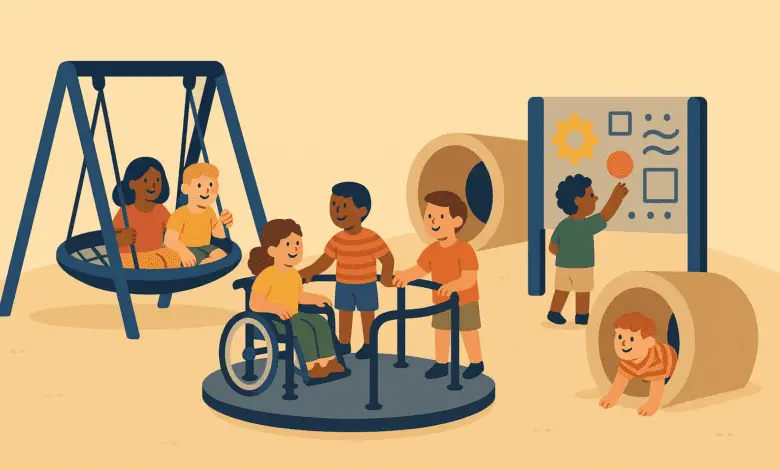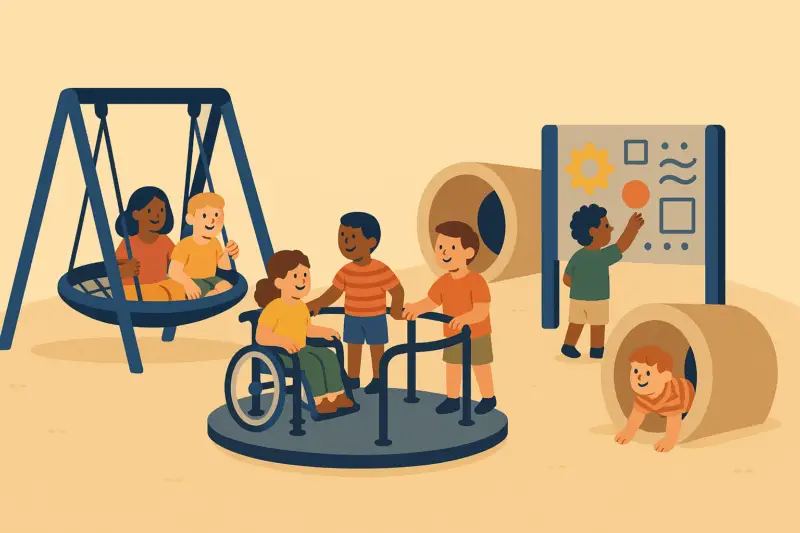
The Rise of Inclusive Playgrounds: Designing Spaces for Every Child
When you think of a playground, what’s the first thing that comes to mind? Perhaps it’s a tall slide or maybe a challenging climbing structure. Or maybe it’s a traditional swing set with metal chains to grasp onto. While these playground elements can be fun, they aren’t necessarily accessible to all children.
Key Takeaways
| Insight | Summary |
|---|---|
| Inclusive playgrounds go beyond ramps | These play spaces are designed to support physical, sensory, and cognitive access, enabling disabled and non-disabled children to play together. |
| Design choices shape real inclusion | Accessibility on paper isn’t enough. Placement, surfacing, and sensory-friendly zones determine whether a playground is genuinely usable. |
| Playgrounds impact more than play | Inaccessible designs contribute to social isolation, family exclusion, and even physical injury. Inclusive playgrounds promote empathy, connection, and shared learning. |
| Only 1 in 10 playgrounds in the UK are inclusive | Despite growing awareness, 47% of UK playgrounds are still completely inaccessible, creating deep disparities in access to childhood play experiences. |
| Families are travelling further and relying more on screens | Many families travel over 5 miles to reach an accessible playground—or default to screen time due to a lack of nearby inclusive options. |
| Good surfacing matters for everyone | Materials like poured rubber and engineered wood fibre benefit all children, reducing fall risk and allowing wheelchair users to navigate play areas more freely. |
| Legal frameworks help—but don’t guarantee access | In the US, ADA rules require accessibility in new playgrounds, but implementation gaps still limit access in practice. |
| Inclusion must address visible and hidden disabilities | Good design considers children with mobility impairments and children with sensory needs, such as Autistic children or those with learning disabilities. |
Disabled children need some specialist provision. They require play areas with specific equipment and thought-out designs that make them accessible. This is why inclusive playgrounds are becoming more and more commonplace.
What Are Inclusive Playgrounds?
Inclusive playgrounds are designed with accessibility in mind. They are spaces that everyone can enjoy, regardless of physical or cognitive ability. This means that the playground’s design is intentional, focusing on how children with various abilities can experience the park. Instead of just adding a ramp for wheelchair access, the playground offers play opportunities that allow children in wheelchairs to play alongside those who are fully able. A merry-go-round spinner, for instance, allows children in wheelchairs and those who are able to stand to play together.
The design focuses on physical abilities, but also on sensory and cognitive elements. Sensory walls with different textures and colors can be illuminating to children with autism or cerebral palsy. A water feature or musical instrument area can be good for children who are overly stimulated and need a quiet moment before rejoining everyone on the playground.
Most importantly, these inclusive elements are built within the playground sets. There isn’t a specific section for disabled children. This encourages social interactions among all children, fostering strong relationships and a sense of belonging for both children and their parents.
Why Are Inclusive Playgrounds Important?
Thankfully, inclusive playgrounds are becoming more mainstream. New parks are making inclusivity a priority, which is beneficial for everyone. Parents of disabled children feel more welcomed when the park can accommodate their child’s needs. Children can focus on having fun and playing, rather than feeling ashamed or left out because the park isn’t suitable for them.
The importance of true inclusion becomes clear when we hear from families directly experiencing these challenges. One wheelchair user shared their mixed experience at what was marketed as an accessible playground:
“I would have loved to catch glimpses of the kids playing while I read; that always brings me joy. Nonetheless, I enjoyed the lovely grass and trees right in front of me.”
This comment reveals a critical design flaw – while the playground had wheelchair-accessible seating, it was positioned where users couldn’t actually see the playground activities, highlighting how “accessibility” on paper doesn’t always translate to meaningful inclusion (Reddit wheelchair user experience).
The profound impact of true inclusion is captured beautifully by another parent who observed their disabled child playing alongside other children:
“His mom said something about how he likes to feel included and just like the other kids. The kids giggled back and forth as they were swinging next to each other.”
This simple scene demonstrates the social and emotional benefits that extend far beyond the physical act of play (Reddit parent observation).
It’s also crucial to recognise that not all disabilities are visible. As one parent explained:
“Not every child looks ‘disabled’ either, my daughter has autism and couldn’t safely/understand how a normal swing works but you wouldn’t know just by seeing her in the swing.”
This insight reminds us that inclusive design must consider a wide spectrum of needs, many of which aren’t immediately apparent (Reddit parent on hidden disabilities).
Playgrounds, while intended for play, create learning opportunities for children. When playing alongside other kids, children pick up social and physical skills. They learn why sharing is necessary and how to compromise. Inclusive playgrounds take these learning opportunities a step further, teaching the importance of empathy and providing lessons in diversity and inclusion. Chances are, a child may not even notice another’s disability during play, which helps reduce stigma.
The Current State of Playground Accessibility
Recent research reveals the stark reality facing families with disabled children across the UK. According to Scope’s comprehensive 2024 Playground Accessibility Report, only one in ten playgrounds are truly inclusive, while 47% of all playgrounds remain completely inaccessible to children with disabilities This exclusion has profound impacts on families, with 49% of families with disabled children reporting that their local playground isn’t accessible to their child. The consequences extend beyond mere disappointment – one in ten families have experienced their disabled child being injured due to inaccessible equipment, and 13% report being unable to enjoy playgrounds as a family because siblings cannot play together safely.
However, even when playgrounds claim to be accessible, design contradictions often persist. One frustrated parent shared their experience:
“They get great new equipment with ramps, and low play areas for wheelchairs. But then they surround it with deep piles of wood chips. They insist they must, because that’s what ‘accessible standards’ are in their code.”
This example perfectly illustrates how well-intentioned accessibility efforts can be undermined by poor implementation or outdated regulations (Reddit parent on design failures).
The Hidden Costs of Playground Exclusion
The lack of accessible play spaces forces families into difficult choices and creates significant barriers to community participation. Half of parents surveyed by Whizz-Kidz in 2025 say their disabled child is excluded from play due to inaccessible playgrounds, with parents of children with physical disabilities travelling an average of 5.37 miles from home to reach a suitable play area. This geographic barrier has led 51% of families to rely more heavily on screen time because suitable outdoor play areas are not available nearby.
The broader impact is equally concerning, with research showing that 31% of all children in Britain now live more than a 10-minute walk from any playground, highlighting a growing “play crisis” that disproportionately affects disabled children who have even fewer accessible options.
In USA, the legal framework supports this inclusive approach. Since 2012, the ADA has required all new and renovated playgrounds in the United States to meet accessibility standards, mandating that at least 50% of play components be accessible to children with disabilities. However, research shows significant gaps remain.
What Are Inclusive Playground Design Elements?
There are so many design elements available which make it easy for builders and planners to incorporate inclusivity into their designs. Here are just a few design elements to consider when building an inclusive playground.

Surfacing
It all starts from the ground up. Choosing accessible surfacing materials, such as poured rubber, artificial turf, or engineered wood fiber, makes it much easier for children in wheelchairs or those with limited mobility to move around the space. These surfaces also do a good job of reducing the impact of accidental falls — which is bound to happen to any child regardless of physical abilities. The key is to make sure that the ground is smooth and free of any obstacles.
The importance of proper surfacing cannot be overstated, as one parent enthusiastically shared:
“They make that ‘pavement’ that is a foamy material with a hint of squish that should be in every damn playground. It is so nice on your joints, and no splinters from eating it on wood chips, and perfect for anyone with any sort of mobility aid.”
This parent’s experience highlights how good accessible surfacing benefits all children, not just those with mobility challenges (Reddit parent on accessible surfacing).
Low-Level Play Structures
Incorporating a few low-level or ground-level play structures can also be advantageous. Sandboxes and interactive panels can be entertaining to all kids. Large tunnels can also be added for kids to enter and exit. These elements also ensure that those who use a wheelchair don’t need to climb any structures in order to access them.
Accessible Equipment
Due to the rise in inclusive playgrounds, there are now lots of options when it comes to selecting accessible equipment. From basket swings to accessible spinners to carousels, there are plenty of ways to offer a wide variety of play equipment. Transfer stations should also be installed so children in wheelchairs can easily get to other areas of the play structures.
Another consideration is the type of handrails and support systems available. Handrails should be added within any platforms and along the edges of most playground equipment. This is particularly useful for children as they are transferring from one area of play to another. Guardrails can also protect kids from accidental falls as they move around.
Quiet Zones
As mentioned, having a dedicated quiet zone on the playground is a welcome reprieve to children who become easily overstimulated. It’s an opportunity for them to step away from the sensory overload and calm down before continuing to play. Having a few benches in a shady area along with a few plants and flowers is all you need. These spots can also be good for parents and caregivers to watch their children.
Where Can Inclusive Playgrounds Be Built?
Anywhere that a playground is installed is a chance to build an inclusive playground! Public parks, community centers, public and private schools, daycares, and churches are all common places for playgrounds. Many states and communities are recognizing the importance of these types of play spaces and are proactively developing inclusive playgrounds as part of their amenities.
Just like any playground, there will likely be special permits needed before construction can begin. Speak with your local representative, school board, or church leader if you’re interested in implementing an inclusive playground in your area.